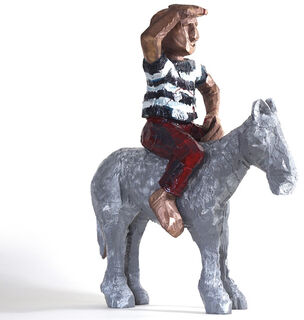Sculpture "manhorse" (2010), bronze
Sculpture "manhorse" (2010), bronze
Quick info
unique piece | bronze, painted | size 54 x 40 x 23 cm (h x w x d)
Detailed description
Sculpture "manhorse" (2010), bronze
Bronze sculpture, painted, 2020. Height: 54 cm. Width: 40 cm. Depth: 23 cm.
About Daniel Wagenblast
The sculptor Daniel Wagenblast, born in Schwäbisch Gmünd, Germany, in 1963, studied at the State Academy of Fine Arts in Stuttgart under Professors Peter Grau and Rudolf Schoofs. Wagenblast has lived and worked in Stuttgart since 1990.
Wagenblast consistently works with figuration, which he doesn't smooth or embellish he rather reveals its materiality with rugged surfaces. The bronze or wooden figures always seem to be removed from the viewers and move in their own cosmos. One of the main protagonists in the artist's repertoire is the world traveller, whom he usually depicts with a gesture of looking out, thus awakening in the recipient associations of a quest, an exploration of the unknown and wanderlust.
Wagenblast has received numerous scholarships, including from the Kunststiftung des Landes Baden-Württemberg.
An alloy of copper with other metals (especially with tin) used since ancient times.
When casting bronze, the artist usually applies the lost-wax technique which is dating back more than 5000 years. It's the best, but also the most complex method of producing sculptures.
First, the artist forms a model of his sculpture. It is embedded in a liquid silicone rubber mass. Once the material has solidified, the model is cut out. The liquid wax is poured into the negative mould. After cooling down, the wax cast is removed from the mould, provided with sprues and dipped into ceramic mass. The ceramic mass is hardened in a kiln, whereby the wax flows out (lost mould).
Now we finally have the negative form, into which the 1400° C hot molten bronze is poured. After the bronze had cooled down, the ceramic shell is broken off and the sculpture is revealed.
Now the sprues are removed, the surfaces are polished, patinated and numbered by the artist himself or, to his specifications, by a specialist. Thus, each casting becomes an original work.
For lower-quality bronze castings, the sand casting method is often used which, however, does not achieve the results of a more complex lost-wax technique in terms of surface characteristics and quality.
A plastic work of sculptural art made of wood, stone, ivory, bronze or other metals.
While sculptures from wood, ivory or stone are made directly from the block of material, in bronze casting a working model is prepared at first. Usually, it is made of clay or other easily mouldable materials.
The prime time of sculpture after the Greek and Roman antiquity was the Renaissance. Impressionism gave a new impulse to the sculptural arts. Contemporary artists such as Jorg Immendorf, Andora, and Markus Lupertz also enriched sculptures with outstanding works.






